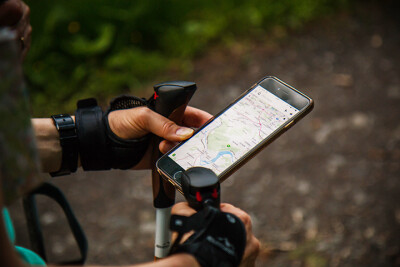It wasn’t all that long ago that we were still using paper maps to get from A to B. We were all adept at scanning a colorful road atlas and experts at deciphering a friend’s cryptic strip map — they’d scribble chicken-scratched instructions on the back of an old envelope: Start here, turn left there, make a right, go a few miles to the big oak and hang a louie. They’d put their phone number on the bottom so if we got turned around we could drop a quarter in a pay phone and figure things out together.
The advent of GPS changed everything. Even those early devices that sat on our dashboards were awesome. GPS made our travels more efficient and kept us from getting lost. But our reliance on it kept us from get truly acquainted with a place. Had us all thinking — Why think about the route when we’ve got technology doing it for us?
Social scientists argue that as tech becomes smarter, humans grow more reliant on it. We all know the addictive nature of various devices and platforms. Some say this reliance leads to laziness, a lack of productivity and scrapped potential. Others claim it’s a slippery slope towards dissatisfaction and unhappiness. Not to mention the fact that looking down at our devices keeps us from looking up at each other.
Back in the Dark Ages
Now I’m no scientist, but I was fitting shoes in the dark ages back when the Brannock Device was the industry’s technological pinnacle. Things changed quickly as we began incorporating fancy bells and whistles into the customer’s fit experience. And not necessarily for the better.
There’s no denying that treadmills, cameras, pressure pads and foot scanners all add unique upgrades to a fitting process that demands regular innovation. And it’s also true that when used properly, all this cool tech increases a fit’s efficacy and, better still, an outfitter’s credibility. But tech has pushed the human element to the back seat and allowed corners to be cut. And sure, the outcomes are acceptable. But is an acceptable outcome good enough?
Specialty running stores made a mark on the retail world by offering something most places overlooked — an empathetic and personalized one-on-one experience with a fellow enthusiast. Customers knew they could walk in our stores and tell their story to a willing ear, who, in turn, would offer relevant advice and suggestions that might improve their activity. This became our calling card and it’s still where we have the opportunity to shine the brightest.
As I travel around the nation and watch outfitters work with customers, it’s evident that tech now demands the attention we once willingly gave customers. Rather than intently listen and allow our curiosity to pique, we often rush to the opportunity to analyze data on a glowing screen. Rather than scratch our chins and solve a customer’s specific problem, we type in a bunch of details, press submit, then rattle off the retort of a “smart” computer algorithm — often without even making eye contact with the customer. This is the wrong way to use the amazing tech we have at our disposal.
Tech Taking Over?
Technology is a marvelous tool in any run specialty environment. But it should always be deployed as a secondary source of information. The primary source should always be the outfitter. They should ascertain foot details and identify the customer’s needs and wants before logging into any device. When tech is used to reinforce something previously mentioned, the expert outfitter inevitably shines brighter.
Spending more quality time with a customer before deploying in-store tech may be a challenge. But make no mistake, mapping the twists and turns of an actual conversation leads to a deeper and more intimate human connection. And this connection helps us make relevant suggestions based on the customer’s unique predicament. This is where we win — because it proves to the customer we’re still a people-focused business in a technology-heavy world. And that’s precisely what we are, isn’t it?






